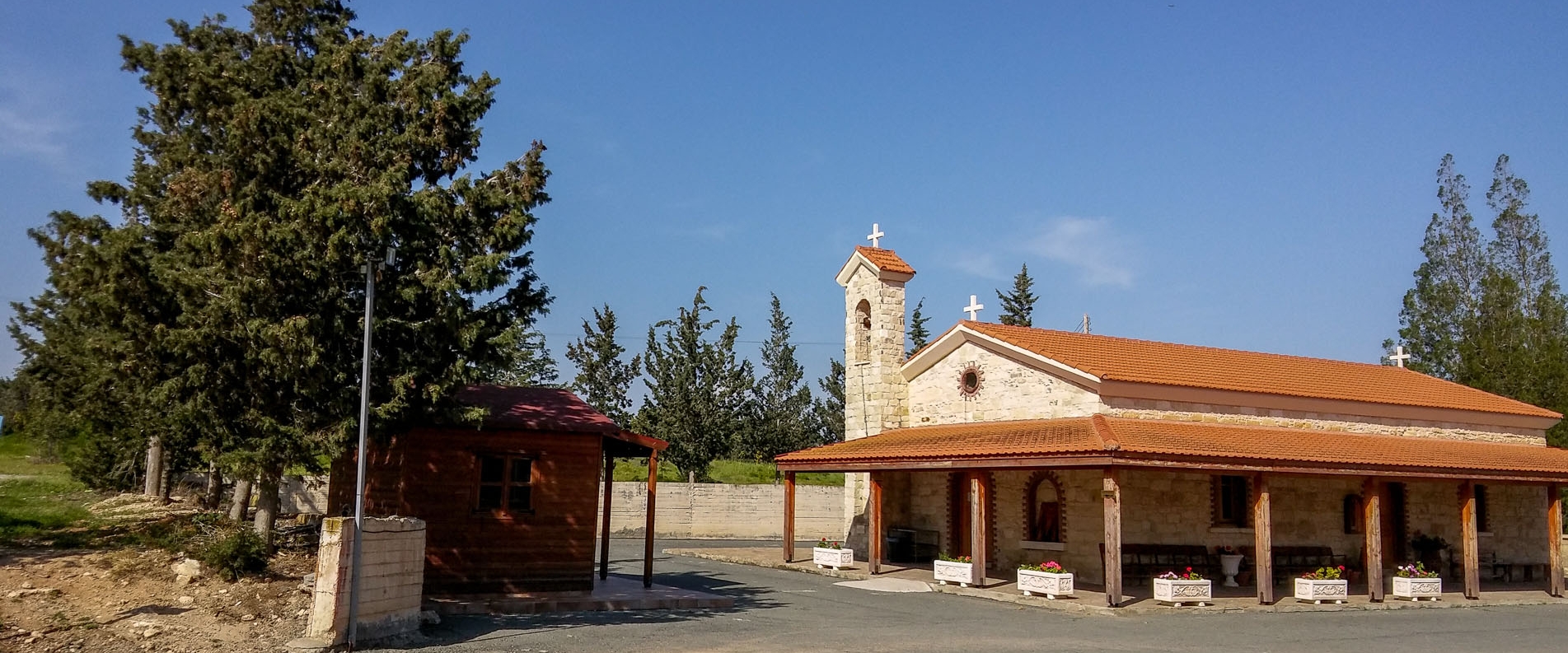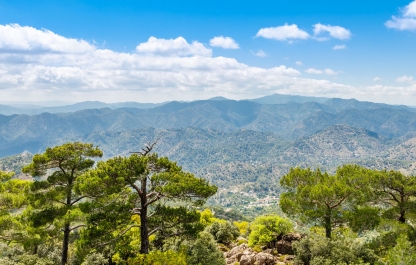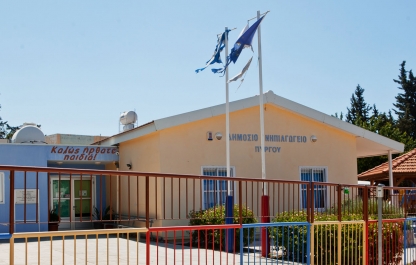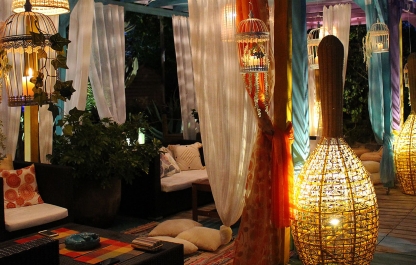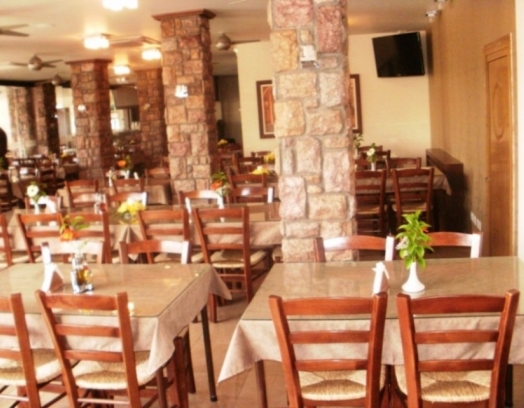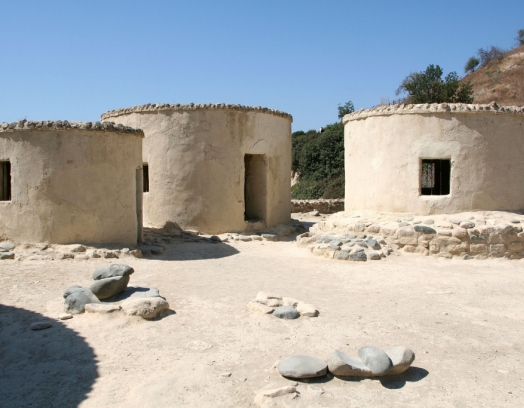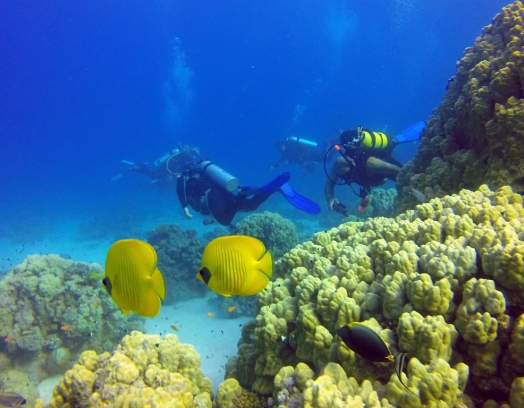If you’re a frequent browser of our site, you know about the peculiarities of having a holiday in the suburban cities of Cyprus such as Paphos, Limassol, Larnaca, Ayia Napa and Famagousta... Here, everyone chooses a “beach” pastime suited to both their taste and wallet size.
Fans of more active types of holiday —the one and only agro-tourism— are well acquainted with the island’s atmospheric villages; some isolated, and some less so.
But today, you’ll discover another interesting and rather attractive spot, housing all the bonuses of a traditional village lifestyle and surrounding pastoral views. All this is in combination with the opportunity to bask in the luxury of the seacoast, while also being in relatively close proximity to well-known centres of culture and entertainment.
So, the suggested route through Mazotos for today: the Church of Saint Xenophon— the Museum of the sculptor K. Argyrou — the village centre and Agios Georgios — the Camel Park — Petraion Park — the Chapel of Panagia Petounta — Mazotos Beach.
A Few Facts
Mazotos is a seaside village close to Larnaca, better yet, its coastline stretches roughly 17-20 km to the southwest of the city. The abundance of greenery in the gardens and parks adds a picturesque hue to the village alleyways, where traditional houses stand adjacent to modern residential quarters. The village is located on a coastal flat plain at an average height of 35 metres above sea level, surrounded by small hills [1]. It reveals a sublime panoramic view of both the surrounding fields and other significant objects in the vicinity, all located on an incline which smoothly descends into the sea. Here, you can also enjoy a breathtaking view of the sea expanse’s infinite azure.
As the village receives an average rainfall of 360 millimetres annually, the agricultural sphere is extensively developed here. Vineyards are cultivated (table sorts and their various kinds); also, citrus, olive and carob trees are grown, along with date palms, grain (mainly barley), various types of edible plants and furthermore — different kinds of vegetables (artichokes, tomatoes, cucumbers, watermelons, courgette, okra) and figs.
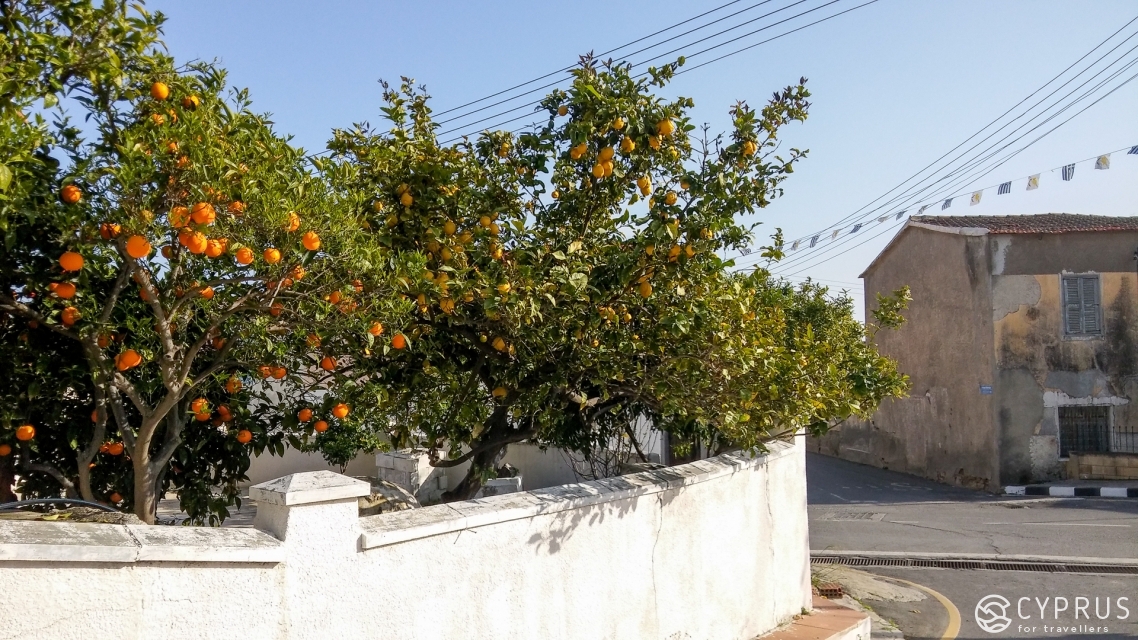
In addition, the village vicinity has long practised animal husbandry, breeding goats: this means that Mazotos also produces halloumi cheese of magnificent quality.
Besides the specific climate traits of this region, the local farmers are significantly aided in their labour thanks to Mazotos’s inclusion in a large-scale irrigation project: the so-called South pipeline. The waters of this pipeline irrigate the region’s territories, which is rather significant to the whole of Cyprus from an agricultural standpoint.
In addition to the water supply, Mazotos is served by a rather well-developed transport network. It is connected to various points by asphalt roads and bustling motorways: in the west — with the village of Alaminos (close to 5 km), to the north-west, with the village of Anafotia (around 4 km) and to the east with Kiti (close to 10 km).
On top of that, there is a coastal road (20 km) running from Larnaca which passes through Mazotos. The village is also connected with the village of Zigi by a coastal road in the southwest that leads onwards to Limassol.
For a long time, the village observed significant fluctuations in its population. In 1881, according to surviving census data, 280 people lived there. In subsequent years, right up to 1946, a natural growth in the population was observed: at that point, it totalled 707 people. Meanwhile, in 1960, figures dropped to 545 permanent residents; in 1976 —soon after well-known political events— a surge was witnessed once again: 608 people then resided in the village.
Based on data from the latest census in 2001, the population of Mazotos has grown to 754 people.
This can be explained by the fact that relatively recently, roughly in the same years, Mazotos began to actively develop its tourism sphere, where construction of residencies for let (cottages and apartments) was moving at a significant pace — today, this form of “Sunday relaxation” is especially in demand amongst residents of Nicosia.
At the same time, this “direction” is gradually garnering popularity with foreign tourists, and also becoming a favoured spot for European pensioners, mainly Englishmen, seeking to enjoy a life of tranquillity.
The Name
Regarding the name of the village, as always, there are several plausible versions and legends.
According to Louis de Mas Latrie (1815-1897), a renowned French explorer [2] of antiquities in Cyprus, the name of the village originates from the name Rhodium spinosum and alludes to the geographical area, where a number of these spiky plants, representatives of the country’s wild flora, are encountered. In fact, for the same reason, you can also find other places on the island bearing the name <<Mazotos>> (for instance, near Pissouri, another coastal village), as well as areas with derivatives of the name, such as Mazeri, Mazeron and so on.
Some etymologists note that the actual name of the village speaks to the likelihood of the settlement initially being named Mazotos— all because, as we’ve already mentioned, the terrain where it is located has hilly formations.
In the past, an inquisitive villager spotted that the shape of the hills was resemblant to the female bosom (in Greek: μαστός), and thanks to this, the village was given its name.
It’s widely considered that over time, the consonant combination “st” was somehow replaced for the letter “z”, which became more commonly used— and so, finally, this is how the name “Mazotos” was whimsically crystallised.
We’ve wrapped our heads around the name, so now for some history: what traces did the people and cultures of the past leave us in Mazotos?
Here, there’s also a thing or two for discussion.
A Snippet of History
These spots, which are no rarity in Cyprus, are historical in their own right, but that’s not all: for example, under the reign of Constantine the Great (272-337), Mazotos was the administrative capital of a Roman province bearing the same name, just like many other provinces: Avdimou, Chrysochou, Koilani, Episkopi, Nemesos.
Important remains have survived providing credible evidence that a Roman road, which connected the ancient city-states of Kition and Amathus, passed through these places specifically.
The Antiquity has left its footprints both on land and the seabed. Thanks to the discovery of fragments from an ancient vessel (dating roughly to mid 4 B.C) at a depth of more than 40 metres, the year 2007 witnessed the beginning of archaeological explorations along the coast of Mazotos, which have continued to this day [3]. This ancient shipwreck of a trading vessel from the late-Classical period, which transported amphoras of wine from Chios and other islands in the North Aegean Sea, is one of the largest wrecks documented on the coast of Cyprus.
The findings were transferred to the Larnaca District Archaeological Museum, where they were recorded in the inventory of the Department of Antiquities, Cyprus.
The reason that this settlement, situated some way from the sea, was initially found by locals from older and smaller coastal fishing villages [4] , is believed to be the numerous Arabic invasions in the 7th-10th centuries.
In 747, this stretch of coast witnessed the naval Battle of Keramaia, which researchers believe to have been a significant victory for the Byzantine empire and so-called “medieval Hellenism”. As a result, a fleet of 13 Arab ships was sunk.
From 1191, Richard the Lion Heart sold the island to the Templars, and right until 1307, Mazotos belonged to the knights of this order (there were a total of 118 Templar monks from all ranks located on the island [5]). It is believed that due to the order’s poor management approach, along with other things, as we know… all their infrastructure was soon passed to the order of Hospitallers, while a large share of the riches fell into the Royal treasury.
During the Venetian era (1489-1571), Cyprus turned into a major oversea power (along with Crete), the easternmost economic colony of the Venetian Republic in the Eastern Mediterranean, and more so, a military stronghold to defend from the “Turkish threat”. As a result, Mazotos once again became the centre point for one of the 12 provinces that the island was split into at that time, under the command of a chivitano— a recognised member of a polis.
There was also a port of great economic significance located here.
In fact, during those days, now an incredibly long time ago, Mazotos was widely renowned for its areas of economic significance, along with its magnificent agricultural produce.
In the vicinity of Mazotos, roughly 3 kilometres southwest of the sea, there lay the Latin settlement of Latorou. It was named in honour of its descendant De La Tour, an influential aristocratic family hailing from France.
Later, when the island was under Ottoman reign, these lands were ultimately bought off in increments by the region’s residents.
Like in any populated area around the world — be it large or small — in Mazotos, countless generations of locals have long kept their “chronicle”. Ieronymos Peristani, one of the researchers mentioned in the village’s official webpage, claims that the first private school in Mazotos was already operating in 1864. It was situated in the small room of Michael Charalambous, a teacher and priest, who only taught until 1868.
Other teachers followed his example, and this tradition survived right until the island fell under British rule (1878-1960).
About Our Visit
Having all this curious information at our disposal, we arrived in Mazotos for the first time. From the very offset, we overly put our faith in the navigator and consequently lost our way a little. For some reason, due to our frequent stops near interesting places, it had evidently deduced we were newcomers to these parts, and purposefully guided us into the nearby debris, leading us on roundabout paths through a string of villages, fields and groves. Nevertheless, through sheer willpower, we were able to find our way out, after firmly setting a course for Larnaca airport.
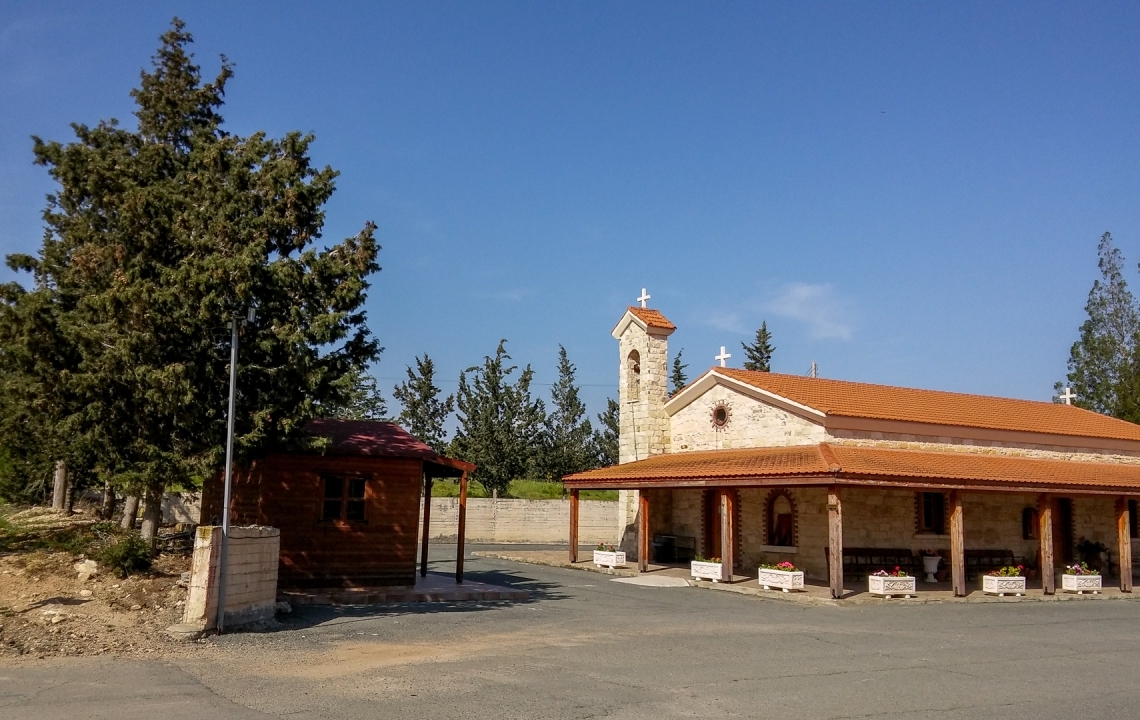
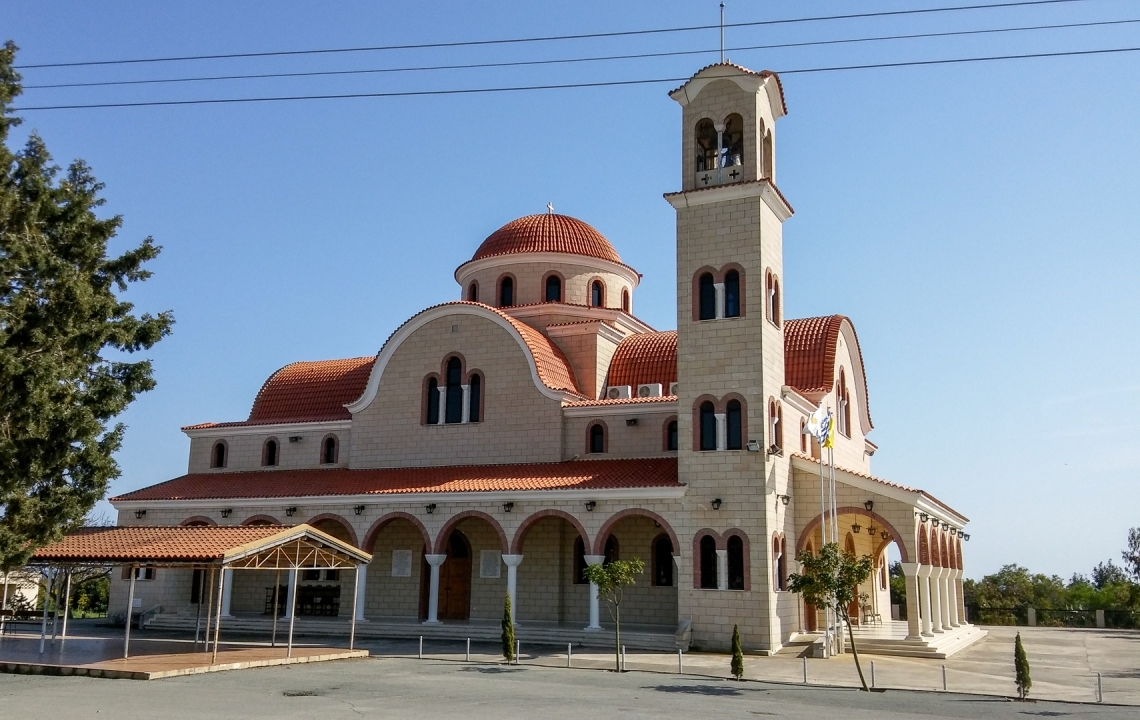
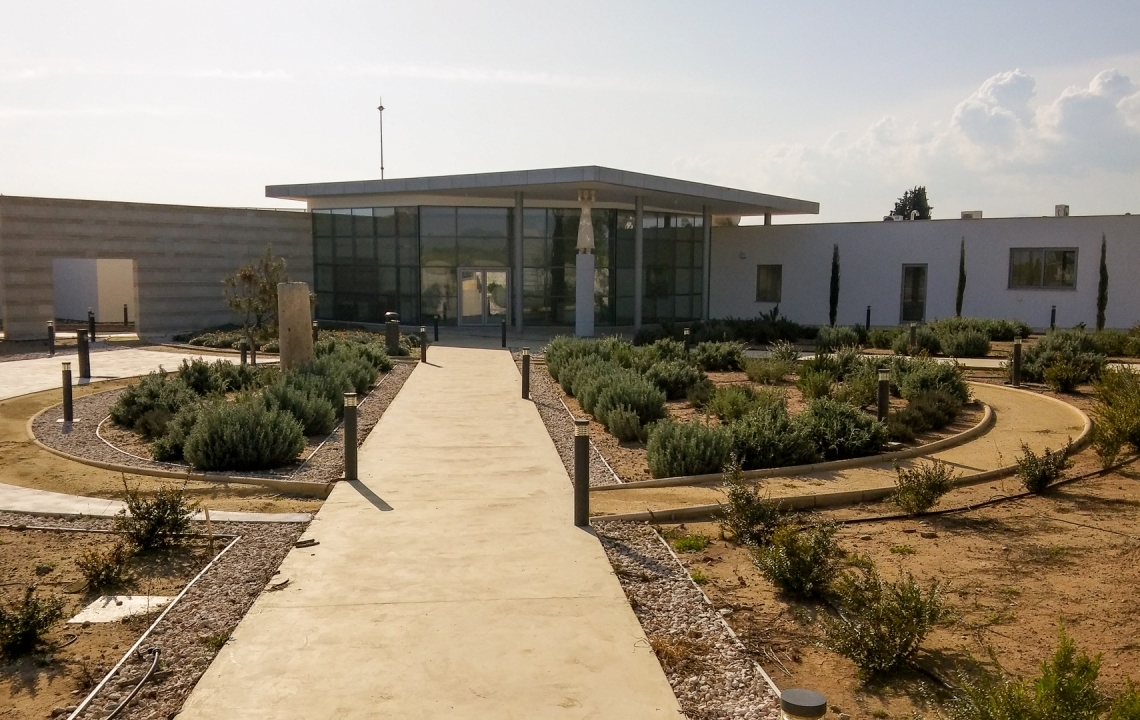
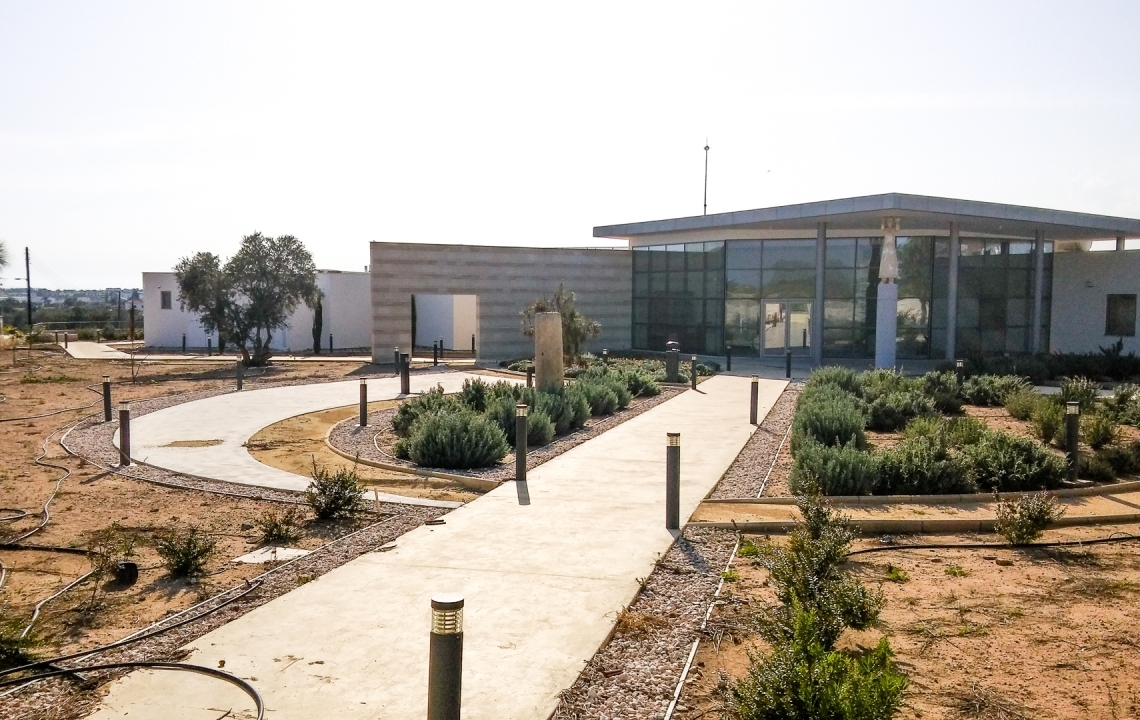
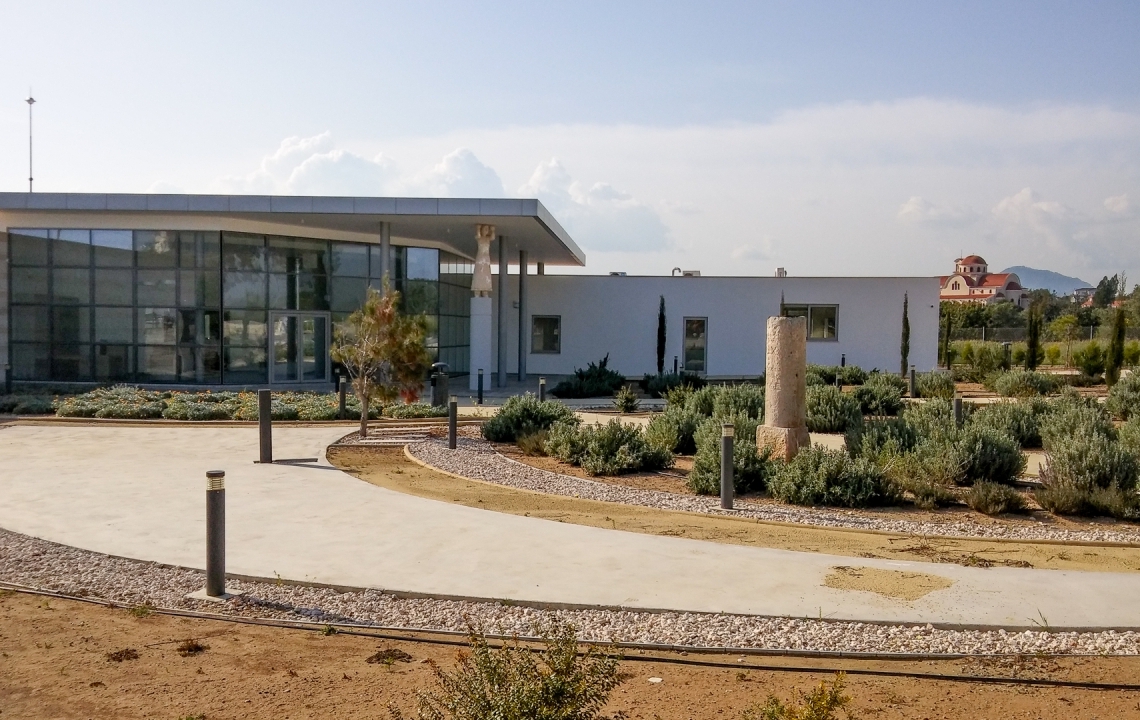
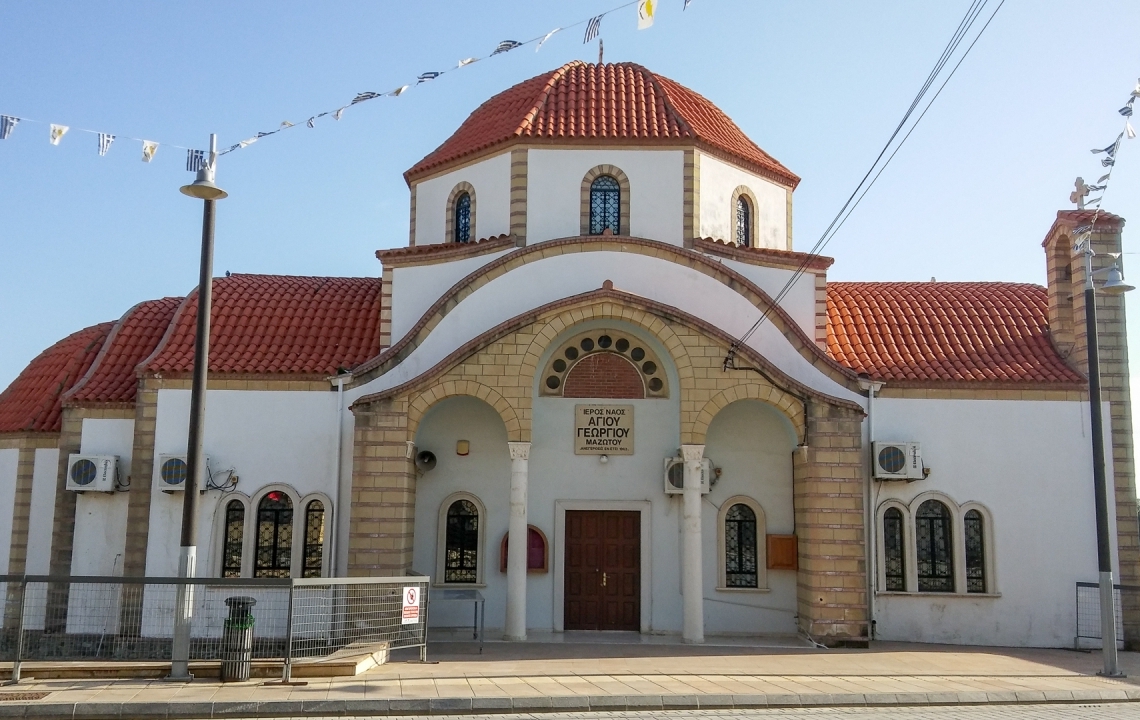
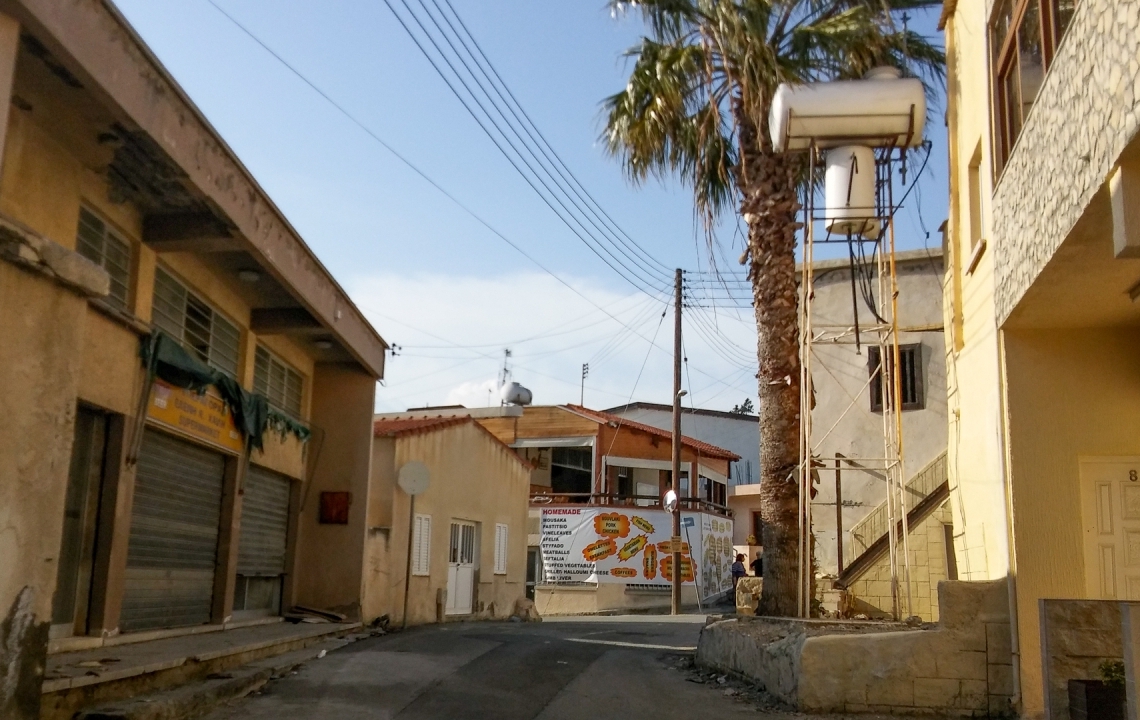
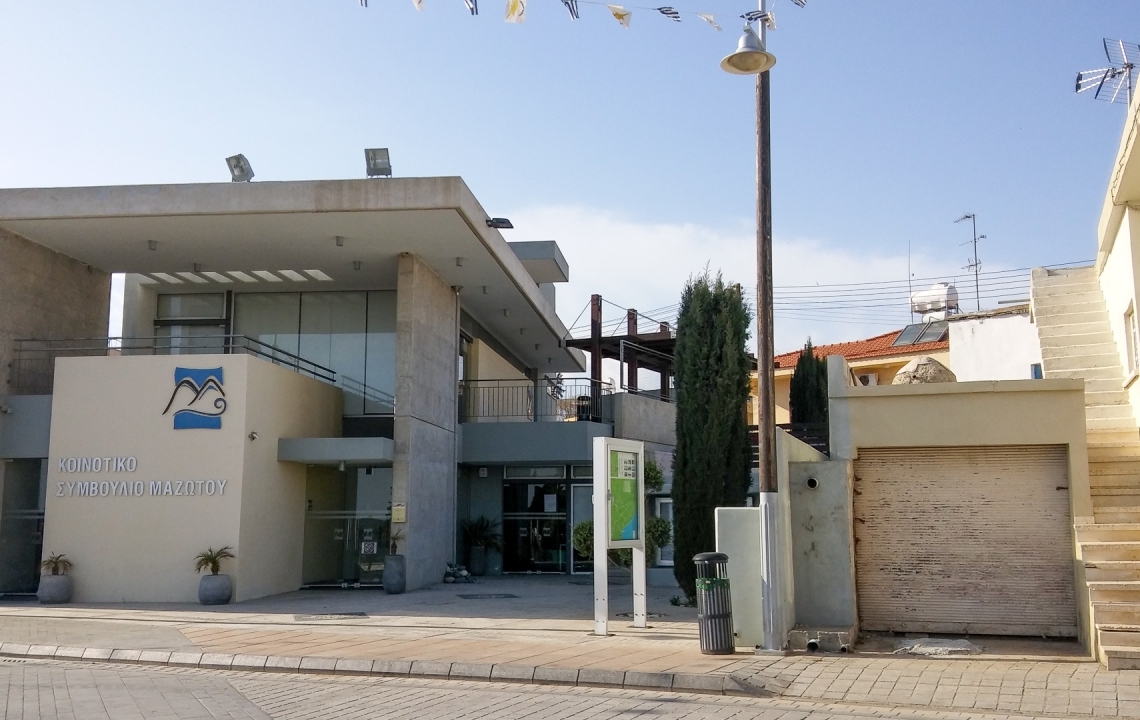
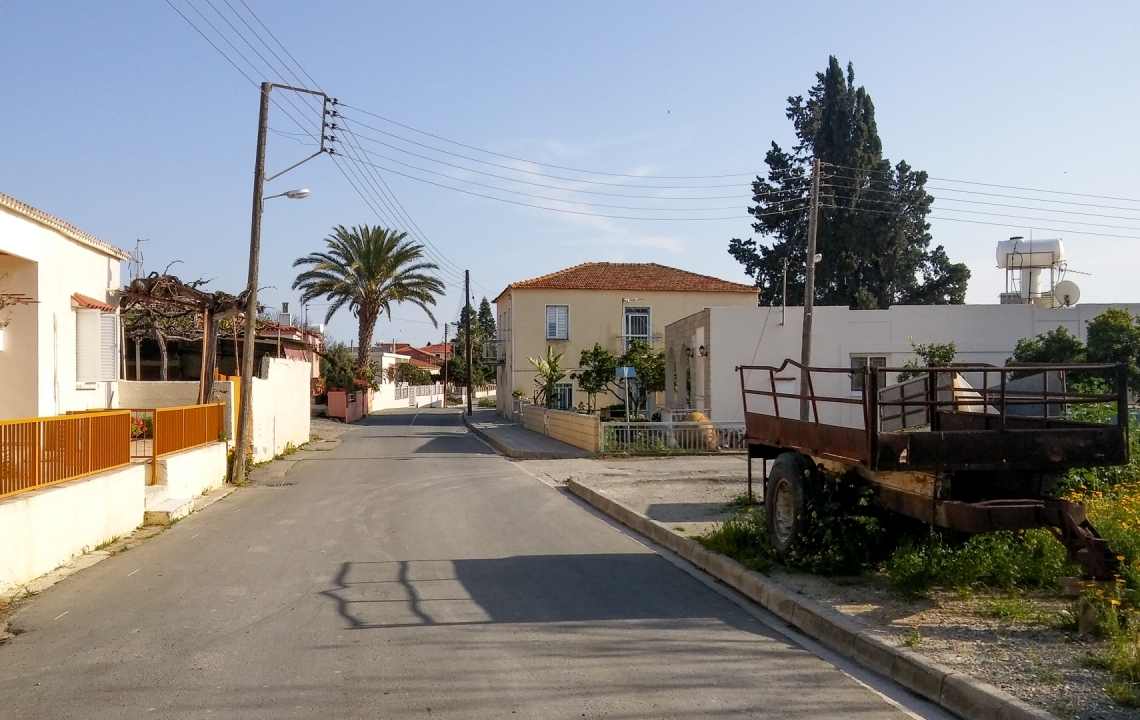
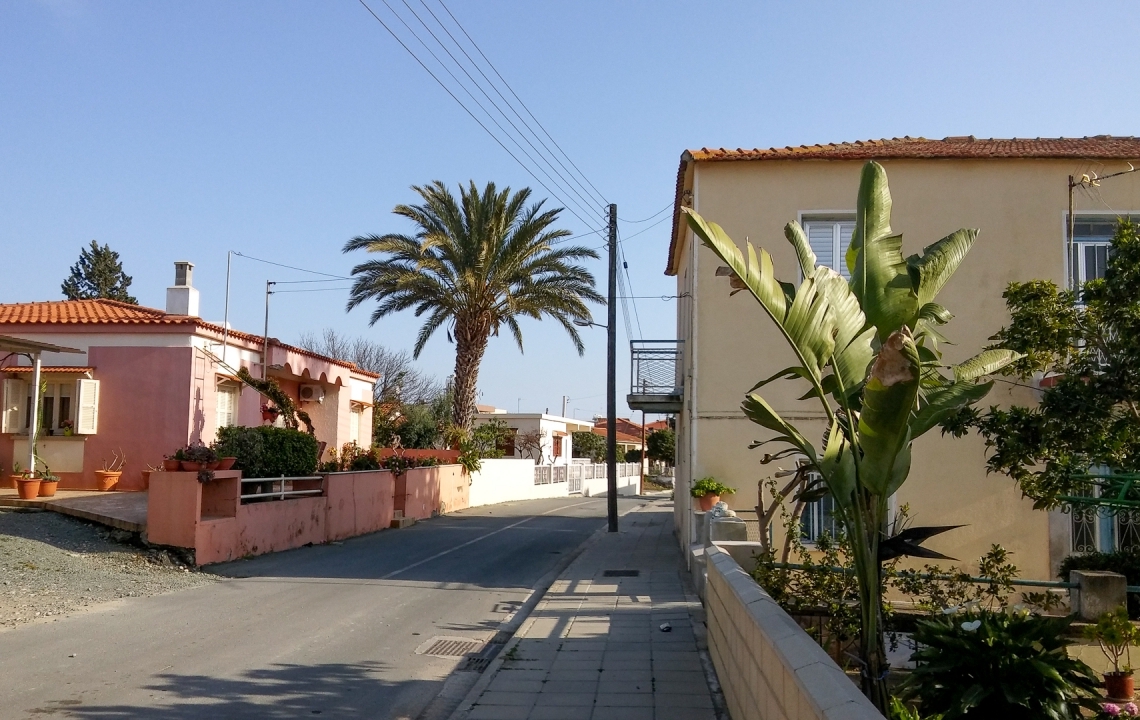
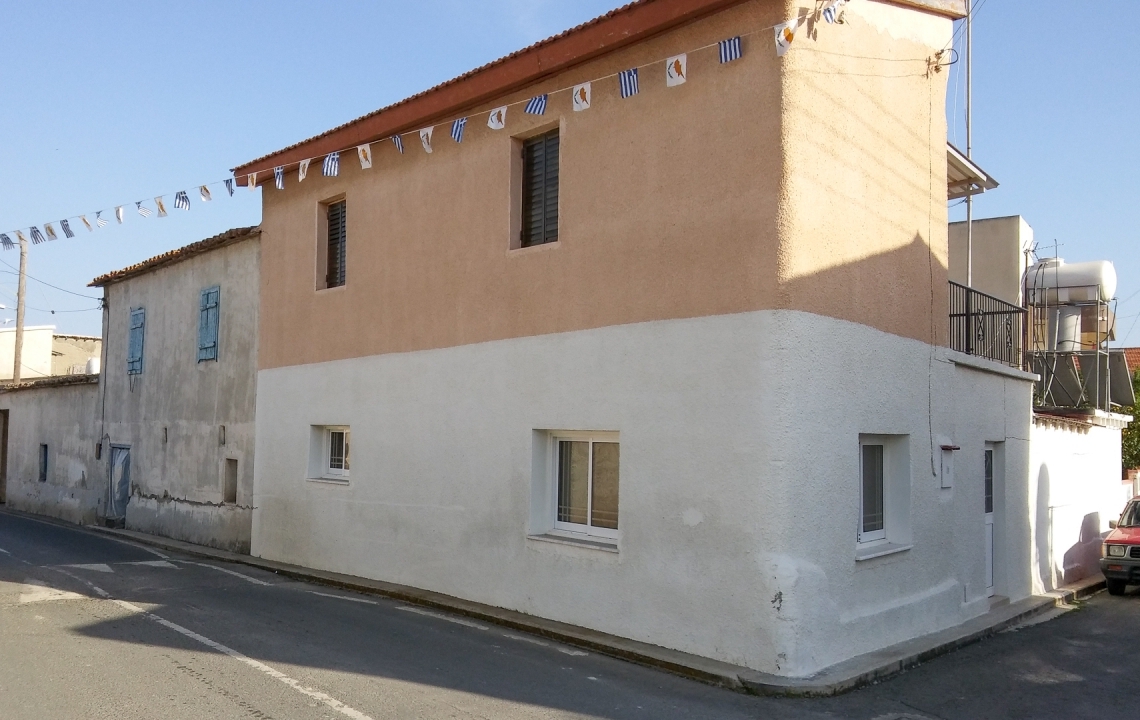
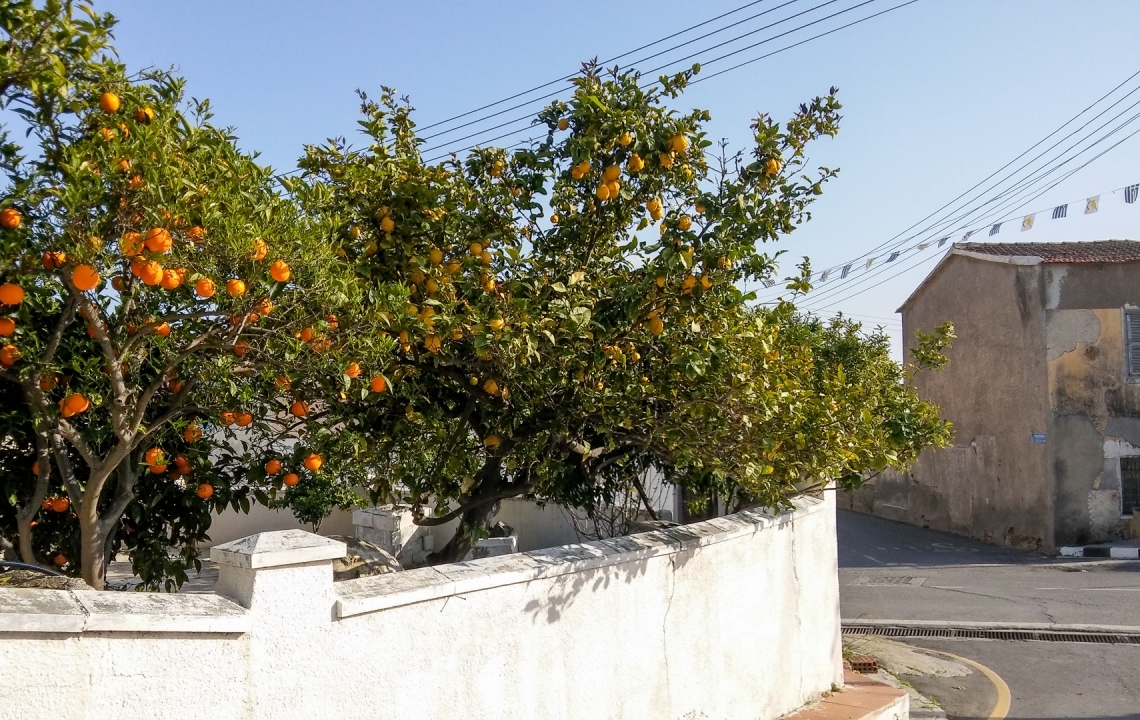
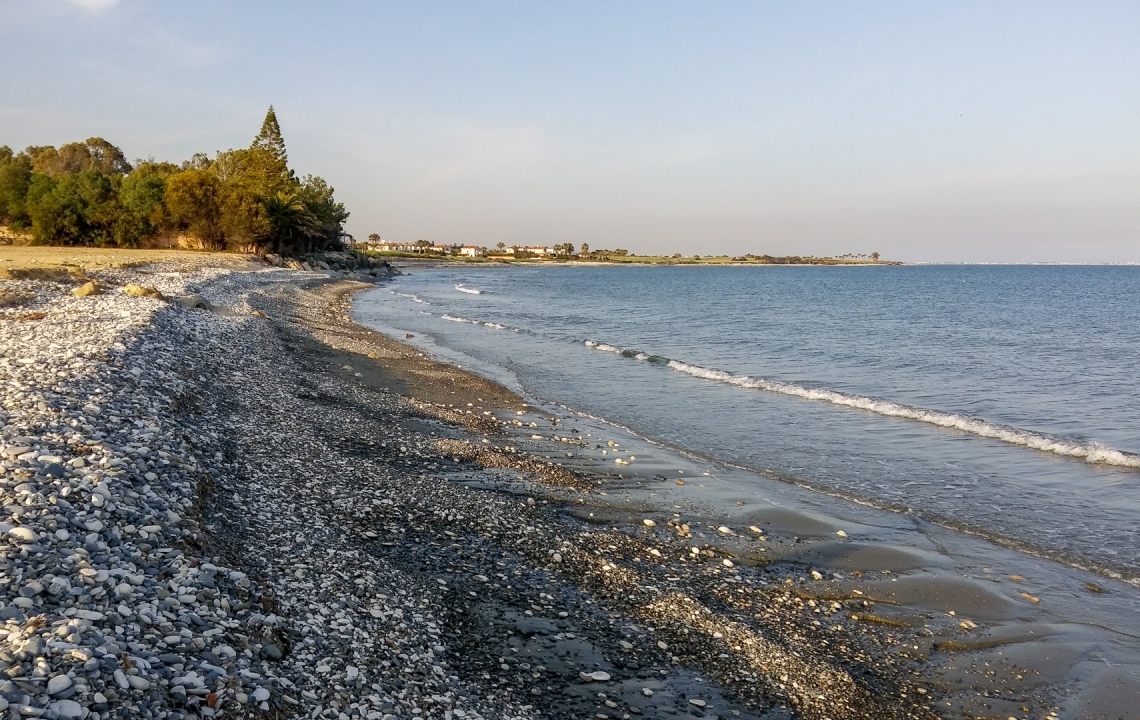
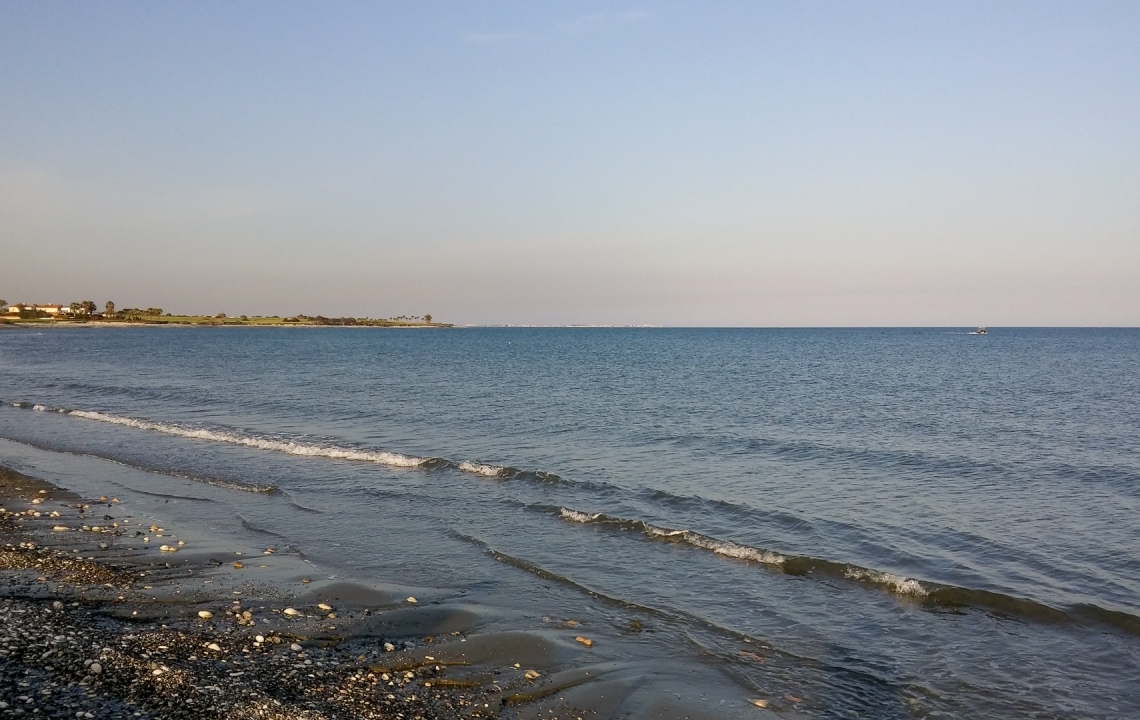
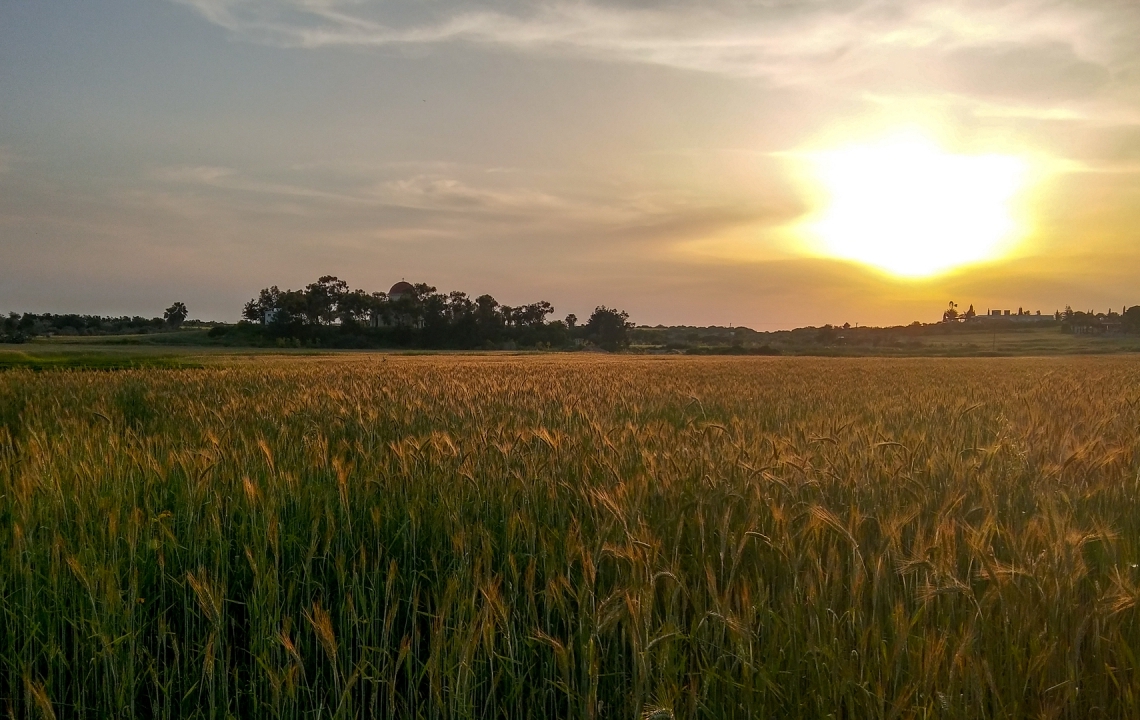

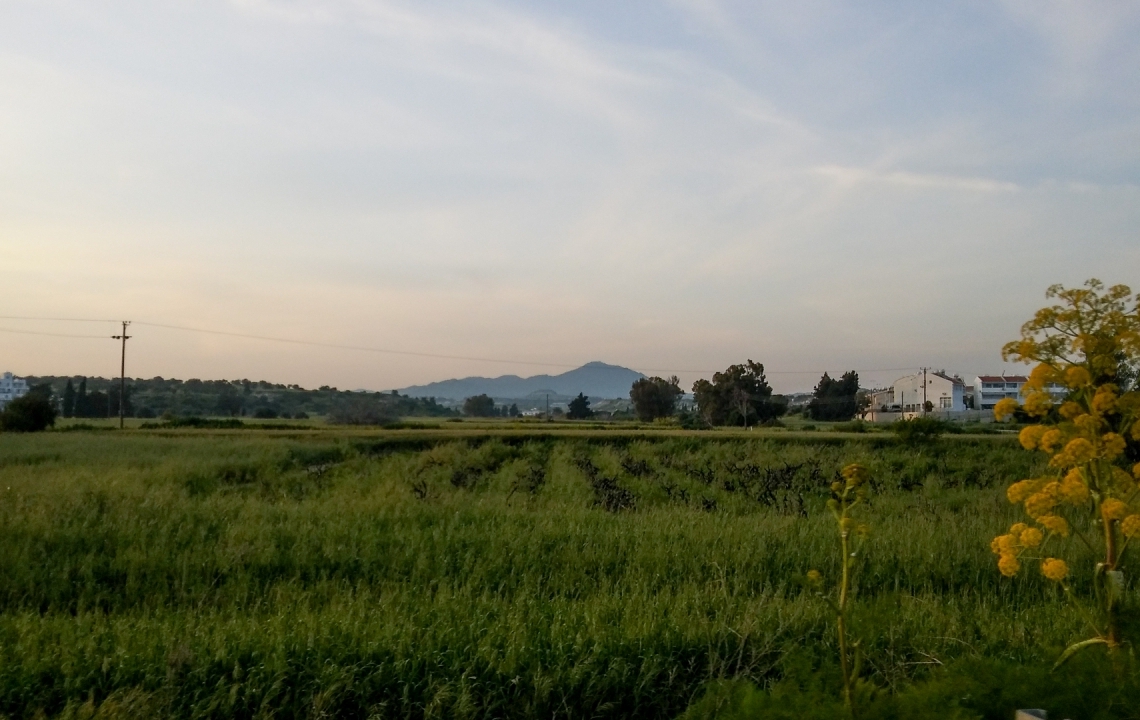
So, after rejoicing at the fact we’d found our destination, we drove along the main road, reaching the turn to the village centre. At the turning itself, roughly 500 metres from the village, there was a grand church, and not just the one… this is where we made our first stop.
Next to a rather new church — a basilica opened on the 24th of October 1999, sporting a tall bell tower and three apses (one for each of the three naves), there stood a small, stone-built chapel. It appeared to have been erected on the site of an old build… in 2009 (funded by Vaco Georgiou, a local villager). Thus, the “old” single-nave church with a bell tower, is younger than its new counterpart.
The Church of Saint Xenophon Zorinou and the Neighbouring Old Chapel
By the entrance to the church recess, there is a printed copy of an old church icon on display. Painted in 1821, it depicts the image of Saint Xenophon with his family. The villagers have preserved the memory that it was brought to Mazotos as a gift by Hadzhidemetros, a cameleer from the village of Vokolida on the Karpas peninsula.
There even exists an interesting legend: one summer night, the Saint himself appeared before this person and uttered the words: “Awake now, deliver my icon to Mazotos, and I will bless the village with many a good deed…”. In the morning, Hadzhidemetros immediately set off for Vokolida, where he stopped for a week. That time, however, he returned to Mazotos empty-handed: in the parish church where the icon of the Saint was located, a priest declined the man access to the icon, claiming no such thing existed…
The Saint had even indicated where the image of him was located, to the right of the iconostasis. However, the stubborn priest was also loathe to concede: before allowing the stranger passage into the church, he and his fellow villagers removed the icon of Saint Xenophon and attempted to hide it underground, in the church courtyard.
And so when Hadzhidemetros came to the church courtyard, accompanied by the curious villagers, Saint Xenophon performed a miracle, and all those present were staggered by the sight that occurred before them: amid the courtyard, a large fire was ablaze. Feeling pure ecstasy at that moment, Hadzhidemetros instinctively approached and began to dig at the ground there. In the same spot, the icon was revealed to him.
After such a sign, nobody dared anymore to oppose the request of this devout messenger, sent by the Saint himself. Unimpeded, Hadzhidemetros took the icon and brought it to Mazotos that night.
Come morning, the entire village had gathered in the home of Hadzhidemetros to worship and pray to the portrait of the Saint. The reverent villagers of Mazotos then took the icon to the old chapel, and a glorious service took place.
It is said that from the next day, miracles began to occur.
Soon after, illnesses and other manifestations of evil began to leave the village (even today, the residents of Mazotos will list to you all the ailments which the Saint has saved them from).
The day of the Saint is celebrated on the 26th of January: every year, it’s a great celebration for the whole village. The event turns into a genuine festival and feast spanning many hours. It welcomes all those who wish to attend and any guests to Mazotos.
There’s an interesting legend which recounts the story of the Venerable Saint, his wife Maria and their two sons Arkady and Ioann (the tale is imprinted on the icon, a copy of which, as we noted, can be seen by the chapel entrance).
On a Russian Orthodox site, we can read the following:
The Venerable Xenophon, his spouse Maria and their sons Arkady and Ioann, distinguished citizens of Constantinople, lived in the 5th century. Despite their wealth and renowned status, they stood out thanks to their kind hearts and pure souls. Wishing to give their sons Ioann and Arkady a more rounded education, they sent them to the Phoenician city of Beirut. By divine intervention, the brothers fell victim to a shipwreck and were cast ashore in different places by the waves. Grieving over their separation, the brothers devoted themselves to God and adopted the monastic life.
For a long time, the parents received no news of their children and believed them to be dead.
However, the venerable Xenophon, already an elderly man, maintained his unwavering hope in God and comforted his wife, Maria, advising her not to grieve and to believe that God would keep their children safe.
Several years later, the couple embarked on a pilgrimage to holy sites. In Jerusalem, they encountered their sons, who had pledged themselves to different monasteries. The delighted couple thanked God, who had united the whole family through his Divine will. The venerable Xenophon and Maria devoted the remainder of their lives to God, accepting the monastic life.
Having bid farewell to their parents, the venerable Arkady and Ioann went into the desert, where after many years of performing good deeds, they became renowned for their gift of miracle-giving and foresight. After pledging a vow of silence and following a strict fast, their parents, the venerable elders Xenophon and Maria, also received the gift of miracle giving from God”. [6].
The church celebrates their memory on the 8th of February.
After taking a look around the church, we sat down for a rest on the nearby church square. By the way, you’ll also find a church shop here, which for some reason is called an “exhibition”, seemingly due to the variety of their “selection”. Aside from the usual cult items: crosses, icons, candles, icon lamps, books and others, you can also purchase works from local craftsmen and fragrant oils.
There and then, before plunging into “historical” Mazotos, we decided to dial back a little and turn off the main road, as instructed, to the museum of Kostas Argyrou, located on a street with the same name. It breaks off right by the museum gates, which lead to a genuine architectural art complex with a budding park (and its own parking), a small, domestic chapel (above the entrance is a fresco with an image of the Saviour) and an unexpectedly spacious, modern gallery building. At the centre of the architectural park composition, there is an ancient column decoratively engraved with graphic symbols.
Kostas Argyrou Sculpture Museum
Mazotos’s art museum is an absolute must-visit. It’s managed by the Department of Cultural Services at the Ministry of Education and Culture for the Republic of Cyprus and features a permanent display of works inspired by village life, as well as natural and religious traditions on the island.
There are some rather interesting facts from the life of K. Argyrou (1917-2001), a master acknowledged as the largest naive sculptor in Cyprus. At 53 years old, he was already a middle-aged man when he began sculpting objects from wood and other materials, as well as painting and crafting mosaics. A talented self-learner, he primarily depicted characters from folk legends and mythology, as well as figures of angels and Christian saints, — naturally, this was alongside images illustrating everyday scenes from the life of Cypriots.
As the animal world also inspired Argyrou, you can encounter various types of birds and fish in his creations.
His works were well-known not only in his native Cyprus, but also in Greece, and were displayed in several other countries.
In fact, the idea to collect his main works in the museum belonged to the master himself: he aspired to leave all his pieces in the very spot where his own life took place. Argyrou created this amazing museum in his beloved Mazotos, where all his works are located to this day.
The collection first opened its doors in 1997, in the presence of Mr Glafkos Kliridis, who was president of the country at the time.
As a true artist, in 2001, Kostas Argyrou left behind an impressive collection of works including sculptures, paintings and applied arts. Soon after, his village home was reconstructed into a sculpting gallery and a modern art space.
Visitors to the museum gallery will be able to appreciate the extraordinary talent possessed by the master— a man who devoted the last thirty-two years of his life exclusively to self-expression in art.
His style was inherent in its slightly naive sincerity, warmth and the grandeur of its execution.
Today, the museum staff are engaged in a planned effort to gradually turn the collection into a centre for promoting art to the wider public. It will also assist in developing the creations of new, budding artists, as well as organising exhibitions, sessions and other events to educate people about art.
The contemporary museum, which is surrounded by a new park and stands as a complex with a small chapel [7] , can be found at the following address:
Kostas Argyros 7, Mazotos village
Opening hours: Tuesday-Friday, 09:00-12:00 and 14:00-16:00; Saturday and Sunday, 09:00-12:00.
Open all year round except on government holidays. Free entry.
Telephone: (+357) 24432277
Facebook: www.facebook.com/kamuseum
Email: ka_museum@cytanet.com.cy
Old Mazotos
We arrived in the centre of Mazotos— on the days we were there, it was generously decorated in honour of the approaching state holiday on the 25th of March. You could see the state flags of Cyprus and Greece hanging everywhere on lines of string.
We were pleasantly surprised by the large-scale repairs and other forms of work undertaken to turn this quiet, classic Cypriot village centre into a genuine, contemporary focal point for the life of its community.
The only (and temporary) setback was the inability to find any suitable parking spots. However, after strolling around the centre and along the old alleyways, we realised Mazotos was actually about to become a modernised place— both ready to receive seasonal guests from different countries of the world and to create more comfort for its permanent residents.
The town hall building— one of the first to be built in a contemporary style— gave no room for doubt in this regard.
By the way, pencil this down: specifically next to the council building (and only there for now), you’ll find an info stand featuring a map of the village and the surrounding sights of Mazotos, both in English and Greek.
And if you come here earlier in the work day and call the secretary Maria Dimitriou on +357 24432800, or message her in advance at Maria@mazotos.org, you’ll be supplied with your own personal map.
As is the case practically everywhere in Cyprus over the last few years, the alleyways represent samples of a typical village build, whose old-fashioned houses have rubbed shoulders with contemporary architecture. I suggest stopping and taking a little look around. What are the unique features of the architecture here?
As is the case practically everywhere in Cyprus over the last few years, the alleyways represent samples of a typical village build, whose old-fashioned houses have rubbed shoulders with contemporary architecture. I suggest stopping and taking a little look around. What are the unique features of the architecture here?
According to Kostas Papageorgiou, a Cypriot researcher and local historian, the houses here are united by adhering to the folk canons of Cypriot rural architecture: mainly two-storey buildings with a small, inner courtyard; clay-tiled roofs; a basement floor at the foundation; also, the houses have small, wooden balconies along the facade.
It’s interesting that despite their visually small size, the residences contain a multitude of spacious rooms inside, connected by either stone or wooden staircases and verandas, located on the inside or outside of the building.
The main church, dedicated to Saint Georgiou, towers in the heart of the centre, located next to some small kafenes.
The Church of Saint George of Mazotos
Agios Georgios is the village’s central church, positioned on the main square, which residents attend every Sunday for services and on days of church celebrations. The cobbled square is currently under active reconstruction, being equipped with all the necessary facilities under today’s standards.
The church was built in 1963 using donated funds from the village community. It was erected on the site of the old church, which had been knocked down to that avail. Before the previous old church was raised, it is said there stood another, very ancient church here, that over time became too small for the needs of its growing community, and so was also knocked down…
Unfortunately, many researchers note that this tradition of periodically demolishing and constructing churches with the same name (as you can see illustrated in many churches and chapels, both in villages and elsewhere) was very detrimental to the national culture and artistic legacy. This was because the consecutive destruction and aspiration to constantly build anew led to a massive loss of valuable wall images (frescoes) and wood-carved pieces of art.
It’s well known that the sanctuary contains an image of Saint George, dated 1777, depicting the Saint holding a sword instead of a spear.
To the best of our knowledge, in ancient times, there were 2 monasteries here, built by Georgian monks. One of the two monasteries was dedicated to Saint George.
The day of the church is celebrated on the 23rd of April.
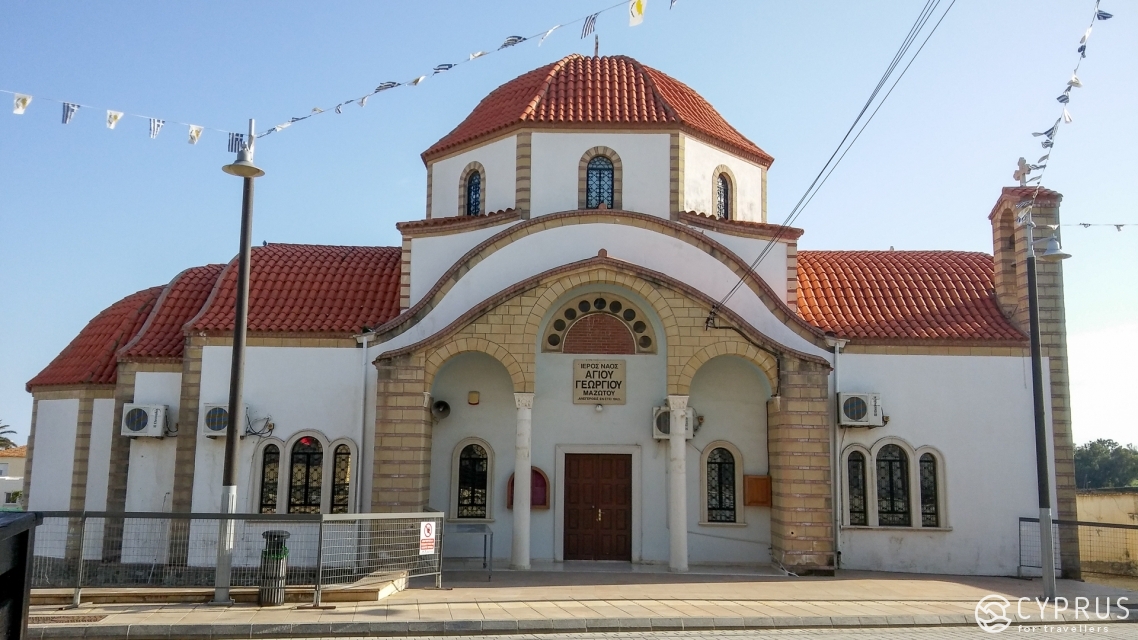
Several forms of work are now being conducted all at once to “modernise” rural life in Mazotos.
Amongst the various projects the administration is leading to benefit its fellow villagers and guests, who are always welcome there, we’ll name the following:
- Laying new roads in the village and the vicinity, including inter-village routes; editing sign posts;
- Constructing new locations, including apprentice workshops and additional classrooms in the primary school;
- Equipping the lecture hall in the town council building;
- Completing construction of the amphitheatre in the central square of Agios Georgios;
- Asphalting the approaching roads to the sea and beaches;
- Laying a bicycle road along the coastline;
- Expanding the local network of water canals.
We’re leaving the centre of Mazotos to ensure we still have time to visit a couple of popular spots.
The Camel Park
A rather famous attraction in Mazotos. As many people note in reviews, the camels here are calm and friendly; they’re eager to make contact with visitors. You can both stroke and feed (you’ll be offered to buy some packets with “treats” for your new friend) the camels, as well as take a short ride on them.
The independent park has zones for leisure and relaxation, such as a playground and attraction spot for kids, along with a restaurant and large swimming pool— for the whole family.
Entry: adults — 4 euro, kids — 3 euro. For a camel ride (including payment for entry and visiting the swimming pool): for adults — 10 euro; for kids — 7 euro.
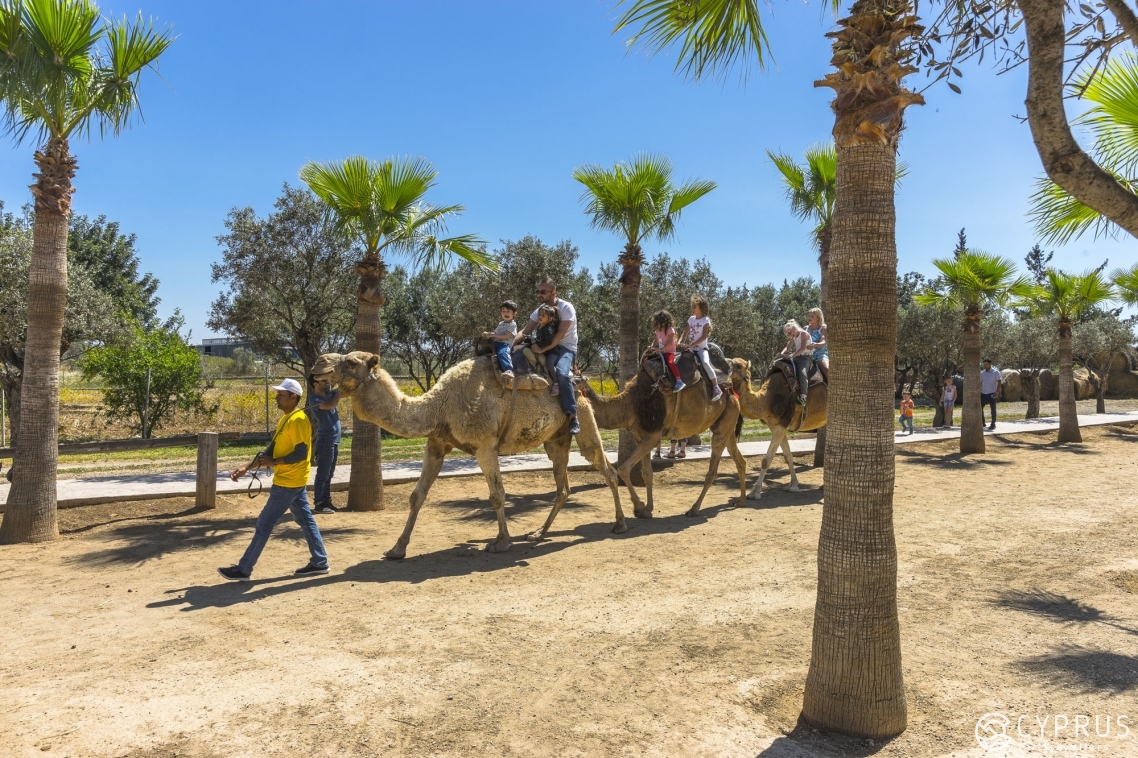
The park is open:
Summer (April-October): from 9:00 to 19:00
Winter (November-March): from 9:00 to 17:00
Contacts: (+357) 24991243, 99416968, 24432711
Email: info@camel-park.com
Website: www.camel-park.com
Getting there: head along the F405 (Kiti-Mazotos) until you see the sign for “Camel Park Mazotos” (near the petrol station) and turn on to Kosta Nadzhikakou street.
The park premises has car parking and is located on two intercity bus routes (No 407 and 409).
Not too far from the camels, there’s another park…
“Petraion” Sculpture Park
An open and very fascinating art space in a spot known to the locals as Plaka, where the sculptor Savvas Koulandros and his wife Stavroulla create magnificent sculptural works and put them on display. It’s common knowledge that all these creations in stone are the result of 14,000 hours of work by both artists.
These original sculptures, impressive both for their character and high level of execution, have been chiselled from different rock types brought from several areas across Cyprus.
A special place amongst the sculptures is held by “Patraios”— a majestic piece, resemblant to sculptures from the Greek archaic age. It depicts the impressively-sized, monumental figure of a naked man, holding in his right hand a himation (a long mantle or cloth, in Ancient Greek), and in his left — a snake or rod similar to a caduceus (a staff entwined in snakes), which was an integral attribute amongst the heralds of the Antiquity.
Amongst the multitude of vibrant sculptural works you’ll encounter in “Patraion”, the following deserve special attention: “Europe”, “The Erinys” and the monument to Grigoris Afxentiou, a hero of the independent movement EOKA.
The park premises has a souvenir shop, a small tavern and a kiosk with drinks and snacks.
Opening hours:
Monday-Thursday from 09:00 to 13:00 and from 14:00 to sunset (!);
Saturday and Sunday from 9:00 until sunset.
The park is closed on Fridays.
Entry: Adults— 2.50 euro, kids — 1.50 euro.
Telephone: (+357) 99648116
Getting there: Head along the F405 (Sigiou street) until the turning where indicated. There’s a bus stop (407 and 409) near the turning for Panagia Petountas street.
As we were leaving the village and its sights, already a little worn out from the experiences we’d amassed over the day, we set a course for the seashore.
And now for the sea…
The Chapel of the Virgin Petounta
One and a half kilometres to the south of Mazotos centre, near the sea stretch on Cape Petounta, stands the old chapel of Panagia Petounta Neroforousa — the Virgin Mother bearing the life-giving liquid [8]. In his book, “Historic Cyprus”, published in 1936, R. Gounis (1899-1965), a collector and governor of Cyprus from 1932-1935, claims the chapel was built on the ruins of a Roman city, where several burial sites were also found.
This small, stone chapel is simple in design and stands surrounded by the remains of what were once likely town walls and tombs. Besides, it is said that archaeologists there discovered a “violin” shaped burial urn, which today is part of the Berlin Museum collection.
Legend also tells that the small hill next to the chapel housed a temple to the Goddess Aphrodite, and the exquisite statue of her still lies under the rubble to this day.
According to legend, the chapel was named Petounta (from the Greek «πετούν» meaning “flight”) because it was in this spot that the Virgin Mary descended from the heavens.
There’s a sacred spring next to the chapel. Legend has it that the spring revealed itself from under the ground to the Virgin Mary, who had stepped down from the heavens onto this spot. Thereafter, the locals would take water to build the chapel. The spring still flows there to this day, and is known as “kanouri”.
Over time, since the Chapel of Petounta could no longer accommodate all its worshippers, a new chapel was recently built in 2013, also dedicated to Panagia Petounta. It stands in a grove on a hill, slightly away from its original counterpart (albeit also near to the seacoast). The chapel was paved with natural stone and built using funds donated by the married couple, George and Elizabeth Ropa.
The new chapel is only open several times a year, on festive days, except for the Annunciation, which is celebrated in the village’s central church, Agios Georgios.
The locals will also be able to recount to you the story of how one of their fellow villagers, Minas, found an image of the Virgin Mother.
It is said that the Holy Virgin appeared to him at night in a dream, indicating the spot of earth that he should dig up to find the icon.
And naturally, the next day, when Minas arrived at the marked spot and began to shovel the earth, he soon found the icon. He spoke of his find to the other villagers, and the decision was made to build a small chapel on the same spot, which they would dedicate to the Holy Virgin.
After using their combined efforts to begin construction, the villagers suddenly ran out of money. Once again, the Virgin Mother appeared before Minas, revealing to him in his sleep where he could find the necessary money to complete the chapel. In addition, the Blessed One uttered to him the words: “You will see many a strange thing, but fear not”.
Late in the eve, the villager went to search for the money in the spot where the Virgin Mary had led him. Suddenly, he saw several animals: camels and donkeys — Minas was scared and fled out of surprise. The next day, he decided to tell all his fellow villagers, who grabbed their pickaxes and headed there. When they began to dig at the same spot, instead of the awaiting treasure, they found a pot full of coal.
After all, the will of the Virgin Mother was for the treasure to be retrieved by Minas specifically.
The Beach and Seashore in the Mazotos Vicinity
The coastline stretches out roughly over 7 km, lying at a distance of 17 km from Larnaca (in fact, you can see it in sunny weather, as the strip of sea bends there), alternating between sandy and pebbled beaches. It’s surrounded by fields, hills with picturesque groves and residences primarily for seasonal use. The beaches of Mazotos have all the necessary facilities and are equipped to be comfortable for holidaymakers.
The Villas Sun Shine cottage plot is one of many such retreat spots that have been offering their rooms to summer tourists for several years (during our stay here at the start of spring, there were few people; only the seasonal foreign workers actively tidying inside the houses and the parking area). It exits onto the coastline, where you’ll find a wild beach.
During our visit to Mazotos, it was still a little too cold for a beach holiday, so aside from us, who’d settled ourselves down on the pebbled beach, there was a young German family with two little ones enjoying the sea’s expanse. Despite the sea breeze growing cold by the evening, they enthusiastically cut through the water’s surface in their boat.
By the way, taking a family holiday here has another bonus, one that’s known to everyone who’s been on holiday to Larnaca at least once: the sea in the village’s vicinity is also rather shallow near to the shore and easy to get in to, gradually getting deeper.
So you don’t make any mistakes when choosing a spot of sea, we’ll give you a tip: the wild beach [9] is Mazotos Beach, while the Secret Paradise (of Alaminos) has loungers and umbrellas you can get at a charge; there’s also Careta Beach which has a playground and swings.
Another thing worth considering a bonus is that the seawater here— as regularly conducted experiments indicate— is very clean.
Aside from beach holidays or relaxing retreats, fans of water sports will definitely be interested in the Kahuna surf house.
N.B. For all the advantages of taking a holiday in these parts, bear in mind that many of the roads leading to the coast are yet to be asphalted, and are by and large unsurfaced.
As for the numerous farming plots, the fields and greenhouses of which you’ll constantly set your eyes on, there are various types of vegetables and grain, amongst other things, growing in the vicinity of Mazotos.
The hilly terrain is covered by numerous groves of olive, citrus and carob trees, as well as vineyards.
It’s worth mentioning two things that are distinguished by their superb taste and quality: the local “tsakisti” olives (cracked-pits), which are cured in brine based on a traditional recipe, and the “Mazotos” trademark olive oil.
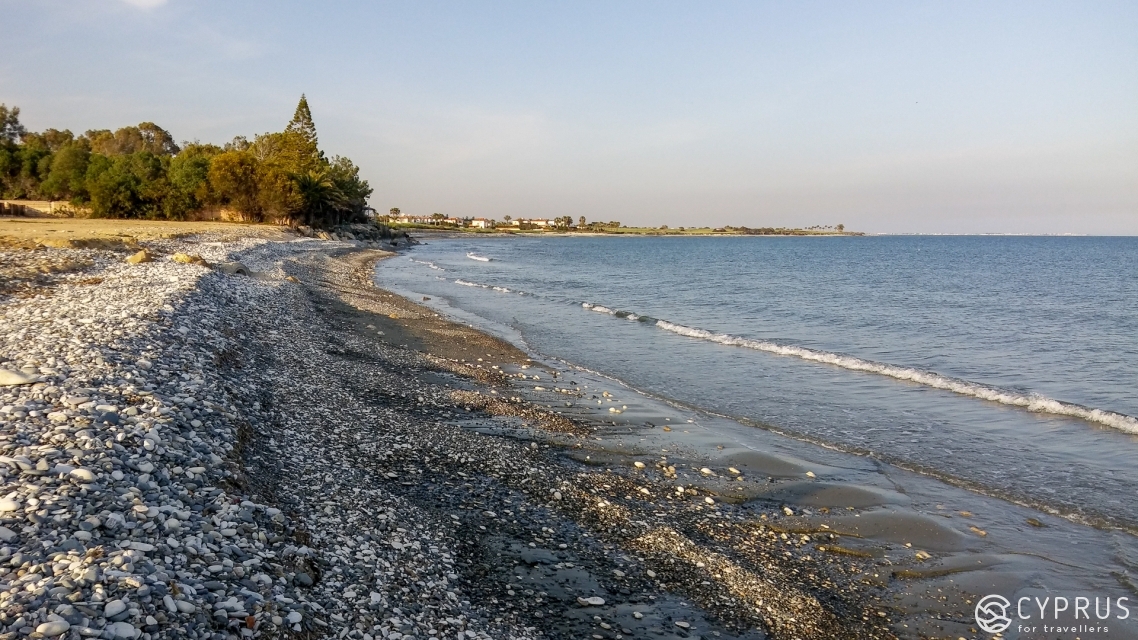
Getting there:
By car: head from Nicosia along the A1-A2 (Nicosia-Larnaca) until you reach the roundabout at the entrance to Aradippou, then follow the direction for Larnaca airport, going first along the A3 until the last roundabout. There, you’ll head for Kiti and then Mazotos along the E405; otherwise — if you’re driving along the A1, choose the direction for Limassol and come off when indicated for the villages Kofinou and Skarinou. At the fork, go along the F107 through Alaminos until you reach Mazotos.
Journey time: around 50-55 minutes.
Bus routes: 407, 409, 450. The 409 goes to the village centre.
Where to stop over:
As we’ve said, there are many new cottages around the village awaiting guests. These “tourist plots” are seasonal hotels.
Judging by the website reviews, one of the most popular plots is the Hadjios Valley hotel (14 two-storey cottages, a public swimming pool, children’s play area and a mini menagerie in an olive grove). Incidentally, this cosy hotel is located only a 10-15 minute walk from the Camel park.
Mazotos Hills 3-4 (5 complexes with 72 apartments, featuring two layout options) could also be a perfectly good spot for a holiday in Mazotos. All the hotel rooms have indoor parking.
Thanks to its pragmatic design, all the complex buildings are positioned at different heights along the hill — to provide an open view of the sea and valley below. The hotel is situated only 300 metres from the centre of Mazotos and has two large swimming pools.
Где перекусить:
Aside from the Camel and Sculpture Parks mentioned earlier, which both have a tavern and restaurant, Mazotos has a fair share of bakeries (the famous Sigma Bakeries), cafes and restaurants, several of which offer food delivery.
One of particular repute is the tavern “Mazotos”: on top of the customary traditional dishes of Mediterranean and Greek cuisine, the tavern has vegetarian and vegan options. It serves breakfasts, brunches, lunches and dinners. The prices are more than agreeable. There are menus in Russian.
Contact: (+357) 24432900.
Former travellers there, especially our fellow countrymen, have noted the rather large portion sizes. They can be ordered for two people, for example, if a child is travelling with adults.
And lastly, one more point: despite Mazotos, as you understand, being full of various attractions, you’re better taking an off-roader to reach them, as many of the approaching roads are unsurfaced dirt tracks. Several of them, by the way, are very narrow (one lane).
Literature:
1. Kostas Papageorgiou, MAZOTOS, A Village With Beauty and History. Cyprus, 2009;
2. Ionas Ioannis, Traditional Professions of Cyprus. Nicosia, 2001.
… and the Mazotos website: www.mazotos.org.
See you soon!
[1] The highest point is one of the hill summits lying to the northwest of Mazotos centre, at a height of 80 metres.
[2] The historian became widely renowned for one of his works: Histoire de l'île de Chypre sous le règne des princes de la maison de Lusignan (1853).
[3] According to the local media: during excavations conducted by an international team of archaeologists in 2018, 70 amphoras and other ancient artefacts were uncovered and raised from the waters of the Mediterranean, in a rather well-preserved condition.The uniqueness and importance of the discoveries made throughout the exploration were confirmed by the staff at the Department of Antiquities, who claimed that the vessel in question was the only famous one ever discovered in the waters of the South-East Mediterranean. On board were clay vessels originating from the Greek island of Chios.
[4] In fact, the region of Mazotos once actually consisted of 46 villages, with a population of roughly 4800 people.
[5] What’s more, at that time, this island, in particular, was the main residence for the Templars. G. Lee writes: “the Templars were better known in Cyprus than in any other place, and the people there were rather fond of them…” (Wikipedia)
[6] See here for more details.
[7] Inside the chapel on the Museum premises, there are paintings and mosaic works which the artist custom-created for churches. It also houses the burial vaults of him and his wife.
[8] From ancient times, right until the present day, Panagia has been revered in Mazotos as the water bearer: in years of drought, the locals perform a cross procession around the fields and carry the icon of the Virgin Mother to ensure the village yields a good harvest.
[9] Don’t be fearful of its “wildness”: after all, it’s this spot which travellers recommend as a perfectly suitable place for families with small children to spend time together.

